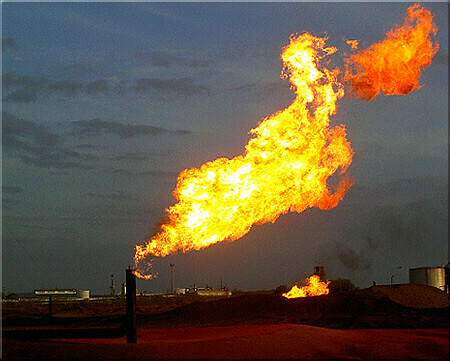We want a future, and natural gas isn’t it

We’re going to die. That is a fact. Another fact is that if the world doesn’t change immediately, it’s going to be a lot sooner than we’d like.
My generation is currently preparing for a future we might not have. We go to school, live our lives, and try not to think about the impending apocalyptic scenarios due to the climate crisis. We’re living with the knowledge that the world may end in our lifetime (if no change occurs).
The climate crisis can be hard to see in Duluth. The harsher than normal winters are easy to blame on “Duluth being Duluth.” The irregular weather patterns are normal in this neck of the woods.
But worldwide, it’s everywhere. The devastating hurricane that destroyed Puerto Rico, the wildfires in California, all due to the climate crisis.
And the reason for the climate crisis is easy to identify – carbon dioxide, methane and other gases being released into the atmosphere. According to the National Oceanic and Atmospheric Administration (NOAA), “The annual rate of increase in atmospheric carbon dioxide over the past 60 years is 100 times faster than previous natural increases.”
Carbon dioxide is a greenhouse gas. It absorbs heat, and then slowly releases it. With so much of it in the atmosphere, more and more heat from the sun is trapped, which increases the Earth’s average temperature.
The carbon dioxide also gets absorbed into the oceans, making it acidic in nature. When the water is acidic, it kills the plankton. This is significant to us as humans as when the bottom of the food chain disappears, it affects everything above greatly. I learned that in biology class years ago.
The climate crisis not only affects the planet and animals, but humans, particularly those made vulnerable by systemic prejudice.
As a disabled activist, I know first hand how marginalized communities are directly affected by the climate crisis. Disabled people, BIPOC, the poor and the global south (among others) are being affected now, and can not wait for solutions 30 years from now.
So where is this extra carbon dioxide coming from?
One of the easiest sources to identify is fossil fuels. Since the industrial revolution, when the burning of fossil fuels began, the amount of carbon dioxide in the atmosphere has radically increased.
This began with the burning of coal for energy. Coal burning has since then been exposed for the devastating environmental impact (although it still exists almost everywhere in America).
However a “better” method is more commonly being used today. The burning of natural gas. Natural gas is constantly being advertised as safer, environmentally friendly and clean.
This is not the reality No matter how secure and regulated the process is, methane and carbon dioxide are always going to be released. From the fracking, to the transportation, to the burning, so much energy is used and so much gas is released by accident.
Natural gas may be “better” than coal, but better is not good enough. We need clean energy and we need it now.
Minnesota Power wants to build a natural gas plant in Superior, Wis. I am currently a member of an amicus curiae (Friends of the Court) group which are appealing that decision on the basis of the financial and environmental impacts. We call ourselves the Friends of the Climate.
We currently have a brief in the Minnesota Supreme Court against this gas plant, and are awaiting its decision. Previously, we won as the Minnesota Court of Appeals denied the permits for the gas plant.
We are ages 17 through 22. We are the future. We are fighting this. Here’s why:
Natural gas breaks the carbon budget. Even without the methane leakage, there’s too much carbon in natural gas for us to stay within the limits set in the Paris Agreement.
The Intergovernmental Panel on Climate Change (IPCC) says that to meet the 1.5 degree goal, the world needs to be half decarbonized by 2030, and fully decarbonized by 2050. How does building another natural gas plant fit into this?
Renewables are the only way, and it’s an easier way. Utility-scale wind and solar power plants are the cheapest form of power, and the cleanest.
Renewable energy emits no carbon dioxide or methane. In fact, it can decrease air pollution. We can never run out of the sun or the wind.
Minnesota Power told the Duluth News Tribune (DNT) that the natural gas plant was for “When the wind doesn’t blow and the sun doesn’t shine.”
However, there’s another solution. Wind and solar plants coupled with batteries can work just as efficiently, and are getting cheaper. Natural gas isn’t needed for grid reliability.
It’s going to cost us – literally. The plant will be owned by Minnesota Power and Dairyland Cooperative at an estimated cost of $700 million. That’s $350 million for Minnesota Power customers to pay.
A survey was conducted by Citizens Group that showed 77% of Minnesota Power customers don’t want the plant. As the generation who will potentially be Minnesota Power customers in the future, we will be paying with our finances and our future.
The climate crisis is here. It’s going to affect the whole world in catastrophic ways. We need to change the way we get our power.
Why add another gas plant when we should be getting rid of the ones we already have?
I am 17 years old. I want a future. This natural gas plant will add to everything that is already taking my future away.
I am begging you, the people of Duluth, consider what you’re doing to your children if you support this. Consider how you’re contributing to the devastation that will ensue when we reach the tipping point.
Take action. Save the world. Say no to fossil fuels. Say no to natural gas. Please ...
Izzy Laderman is a 17-year-old disabled climate activist located in Duluth. She attends East High School as a senior and is getting ready for college next year, where she plans on majoring in history and becoming a history teacher, always with climate justice on her mind.
